Intelligent Swarm: Concept, Design and Validation of Self-Organized UAVs Based on Leader–Followers Paradigm for Autonomous Mission Planning
Abstract
1. Introduction
- Mission planning: Unlike single-UAV systems, missions performed by multi-UAV systems are executed in a parallel and distributed manner to be completed faster [1]. This paradigm of computation involves two main challenges. The first challenge concerns the partition of the exploration environment into subareas. Depending on the homogeneity of the swarm, each area must be assigned to a UAV with respect to their local perception. This becomes even more difficult when dealing with a nonhomogeneous swarm operating in a dynamic environment. The second challenge relates to the collaborative execution of distributed tasks. Tasks must be allocated adaptively to allow for a high degree of parallelism if the UAVs are heterogeneous [11]. Alternatively, it will be handled based on the workload and computational capabilities of each UAV. In addition, the execution of the mission must be based on a consensus control [38,39,40] that promotes collaborative decision making in which the tasks carried out by the UAVs make it possible to converge towards a common goal.
- Mobility: Navigation of the UAVs inside the swarm is organized in a tight formation [11,31,43,44]. Sometimes the swarm is organized hierarchically, according to the type of mission or action performed by each UAV. Issues emerge when the relative locations and directions of the UAVs vary. The difficulties to be addressed include avoiding crashes and collisions, obstruction detection, and signal stability within the swarm [11,45].
- Communication: A single UAV must maintain a constant connection with the ground control station. A multi-UAV system, on the other hand, may have a unique UAV (gateway UAV) [11] that communicates with the ground control station and relays the messages to other UAVs [1]. The communication in the swarm is challenging because of the high mobility of the UAVs. To ensure a good communication signal, drones should be close to each other. The multi-UAV systems must guarantee interoperability in case the swarm consists of various types of drones independent of their communication protocols [11]. In an outdoor environment, interferences can disrupt communication and therefore, hamper the mission [26].
- Energy consumption: Due to the small size of the drones, they cannot carry a substantial power supply [34]. Power limitations impact swarm communication, mobility, and flight time. Therefore, the coverage paths and the collaborative tasks must be optimized to significantly reduce the energy consumption of the UAV fleet [5,11]. This task is challenging and involves two major factors: (1) communication energy used for signal processing, routing protocol, and packet transmission of embedded sensors and (2) propulsion energy used to ensure drone mobility (speed, acceleration, propulsion type, altitude, and so on.) depending on load capacity and mission types.
- Resilience: In a single-UAV scenario, if the running instance is stopped because of software or hardware failure, the mission fails [1]. Multi-UAV systems should avoid single point of failure (SPOF) because they need high availability and fault tolerance against running issues and hardware failure. If one UAV of the swarm is stopped, the mission must continue to operate on another available UAV, assuming downtime. It is challenging to implement a disaster recovery mechanism that describes how the swarm can continue to operate when a failure appears in multi-UAV systems. This is a three-stage process, and a few factors need to be considered, including the following: (1) Problem identification: This could be a collision, a crash, equipment or sensor failure, or bugs. (2) Drone selection: In the second step, we determine which drone will be tasked with continuing the execution of the failed task. (3) Business continuity: This involves determining the status of the mission to restart where the execution failed or go to fail-safe procedures (safe termination of the mission).
- Because the area of autonomous aerial systems is still in its early stages, there is a scarcity of formal understanding of swarm intelligence. There is a lack of stable, reliable, and scalable multi-UAV system architecture that supports the collaborative actions of self-organized swarms. In this regard, our research provides substantial value by filling the gap in the design of actions performed by an autonomous swarm.
- In most research, multi-UAV systems rely on a centralized communication infrastructure at the GCS. In this sense, the added value of our communication model is that it is based on a decentralized single-group architecture that can be extended to a multigroup one [11]. Thus, we suggest removing the dependency from the GCS and promoting UAV-to-UAV communication without operator involvement. This communication infrastructure is rarely implemented in existing works because of its susceptibility to failure, which we must address.
- The study of intelligence and collaboration inside an autonomous swarm is challenging, with relatively few papers that completely investigate the complexities of how they operate. For example, the problem of the high availability (HA) and resilience of UAVs is not addressed in most works. Added to this, there is a lack of tracking and control of the mission being carried out in the swarm. To compensate for these omissions, we integrate a swarm management policy, and local rules based on consensus control, resulting in a scientific contribution that brings valuable knowledge to bear on the question of how to ensure high availability, fault tolerance, and resiliency when a UAV breaks down or in the event of bugs/collisions. We have proposed a series of ROS services that run continuously to ensure the proper functioning of a multi-UAV system.
2. Background and Existing Works
2.1. Swarm Intelligence
- Task allocation enables emerging tasks to be distributed dynamically between the different UAVs in the swarm. Its purpose is to enhance the overall effectiveness of the swarming system [37,48]. If the swarm is homogeneous, the tasks can be allocated equitably. When the UAVs have different capabilities, the tasks may be allocated according to the workload capacity of each UAV [11,37].
- Collective perception merges the data perceived locally by the swarm’s UAVs into a complete image of the environment. It enables the swarm to make collective actions, such as multitarget tracking [31], efficient coverage mission [24], allocating a suitable proportion of UAVs to a particular job, or determining the optimal solution to a global problem [11,37].
- Synchronization aligns the rate and timing of the swarm’s clocks. As a result, the UAVs acquire a common time, allowing them to conduct harmonized tasks.
2.2. Swarm Mobility
- Object clustering and assembly: The swarm of the UAVs can target spatially distant items that are geographically separated. These are essential for construction processes [37].
- Collective transport allows the collective movement of the swarm to carry heavy objects for individual drones [47].
- Collective localization allows the swarm’s UAVs to determine their relative position as well as orientation with regard to each other by establishing a system of local coordinates across the swarm [37].
2.3. Swarm Application
2.3.1. Environmental Exploration
2.3.2. Reconnaissance and Surveillance
2.4. Industrial Applications
3. Materials and Methods
3.1. Swarming Concept
3.1.1. Stage 1: Area Partition
- , we have that is a nonempty space.
- , we have that and are disjoint two by two.
- .
3.1.2. Stage 2: Mission Planning
- A core processor can perform at most one ROS node at a time. Thus, if , and , then for .
- If , this requirement reflects the fact that the node corresponding to job can only start after the node corresponding to job has been completed.
3.1.3. Stage 3: Message Passing
- : holds message that has sent to the other {}.
- : holds messages that have been received by .
- for all . This means that publishes messages throughout the swarm.
- such as . This means that subscribes to the published messages of the .
- and . This means that is on standby.
3.2. System Architecture
3.2.1. Application Tier
3.2.2. Computation Layer
- , , and all ROS nodes run.
- For a given , the running nodes are different two by two, .
- Once all the nodes have been completed, we obtain .
3.2.3. Service Thread Pool
3.2.4. Communication Scheme
- SYS ID: System identifier assigned to each drone. Its value varies from 1 to 255.
- IP: The IP address used to identify the drone on the wireless network.
- PORT: The listening port used by the GCS and drones to send/receive packets and commands.
- CHANNEL: Communication channel used by the GCS to transmit telemetry data to the fly control unit of each drone.
- BAUDRATE: Speed at which each drone transmits and receives data.
- Heartbeat signal is a periodic message sent at a lower frequency by each drone to indicate that it is alive and operating normally.
- Telemetry data provide feedback (waypoints, altitude, position, roll/pitch/yaw, speed, IMU, and diagnostics) concerning the drone’s mobility.
- Mission control messages contain instructions (such as take-off, landing, set mode, rtl, etc.) used to send mission control commands with higher priority and frequency.
- Sensor information contains raw data from onboard sensors (e.g., GPS, GNSS) or cameras (e.g., thermal, spectral, or hyperspectral camera).
- Parameter set contains standard definitions (e.g., HEARTBEAT, SYS STATUS, or PARAM VALUE) used for the management of the multi-UAV system.
3.3. Self-Organization
3.3.1. Consensus Control and Policy
- MissionPlanner autonomously manages the assignment of the mission tasks on the whole swarm. The tasks are assigned to only active UAVs within the limitations of resource capacities, queues, and so on. It is referred to as a pure mission planner, which means that it does not track the status of the mission. Upon mission or UAV failures, the MissionPlanner reschedules the failed tasks to other active UAVs.
- MissionManager is responsible for monitoring and tracking the status of the missions running in the swarm. It continuously receives information about the status of the drones and the mission in progress. It handles the execution of the TaskManagers in the swarm and commands the DroneManagers to restart the ROS nodes in case of failure.
- TaskMaster is the component that negotiates the allocation of resource usage (CPU, memory, and disk) for executing the tasks on the ROS nodes. Its main role is to coordinate the execution of the mission tasks and handle faults. It reports the status and progress of the running tasks to the SwarmManager. Once launched, it transmits frequent heartbeats, as well as the diagnosis of onboard sensors to the SwarmManager to assert its health status.
- ROSContainer is a collection of ROS nodes used to perform the computation of the tasks. For each ROS node, hardware CPU, ram, and disk resources are allocated to the follower UAV for the running of the assigned task.
3.3.2. Fault Tolerance and Failover
4. Experimental Results and Validation
4.1. Proof of Concept: Rapid Coverage Mission
4.2. Flight Time vs. Number of UAVs
4.3. Energy Consumption vs. Number of UAVs
4.4. Network Bandwidth and Latency
4.5. High Availability
4.6. Comparative Study
4.7. Key Problems and Limitations
- Asynchronous message passing interface: As this communication model does not implement instantaneous acknowledgment, it is therefore unreliable due to the risk of lost packets, data inconsistency, or out-of-time delivery. This can hamper the smooth running of the mission and optimal control of the swarm by the leader. In addition, the retry mechanisms of these buffered messages can lead to communication bottlenecks.
- Network stability: A number of external factors, such as noise, wind, trees, hills, and the effect of highly urbanized areas, can alter network stability and cause communication delays due to degraded signal quality. In such situations, signal power can vary from extremely low to very high, with a greater probability of being close to zero.
- Swarm mobility: The drones have a short communication range, which limits the swarm’s mobility in restricted areas. They must therefore always remain within the GCS transmission range. As a result, the drones will be close to each other. This can lead to collisions and signal interference. In practice, the proximity of one drone to another causes interference. This occurs when the signal from one drone’s receiver interferes with that of another drone. As a result, network stability is often disrupted, affecting not only latency but also the delivery of transmitted raw data and telemetry.
- Energy constraints: Battery life has a direct impact on swarm performance. A drone with a low battery takes longer to react to cooperative actions and coordinate these movements with the others. This can hamper the convergence of consensus control and, in the worst case, lead to paralysis of the multi-UAV system when it comes to the leader drone.
- Security: Our multi-UAV system is not secure, as the proposed communication scheme does not incorporate a security layer to protect data and the swarm. This vulnerability can be exploited by an attacker to initiate routing, jamming, and denial-of-service (DoS), Sybil, or Byzantine-type fault tolerance attacks.
5. Conclusions and Future Work
Author Contributions
Funding
Data Availability Statement
Conflicts of Interest
Abbreviations
| UAV | Unmanned Aerial Vehicle |
| GCS | Ground Control Station |
| VTOL | Vertical Take-Off and Landing |
| ROS | Robot Operating System |
| SIL | Software-In-The Loop |
| LMAT | Localization with a Mobile Anchor node based on Trilateration |
| MAS | MultiAgent System |
| UDP | User Datagram Protocol |
| FIFO | First In–First Out |
| CPU | Central Processing Unit |
| C-UAS | Counter-Unmanned Aerial System |
| RAM | Random Access Memory |
| SPOF | Single Point Of Failure |
| RRT | Rapidly Random Tree |
Appendix A
| A | Area |
| Subarea of A | |
| k-partition of the area | |
| Drone i | |
| State of | |
| Altitude of | |
| Perception capability of | |
| Swarm composed of k UAVs | |
| M | Mission |
| k | Number of UAVs |
| m | Number of jobs associated to M |
| p | Number of processor cores per UAV |
| job of M | |
| core of | |
| Execution time of job i | |
| task (ROS node) of | |
| Workload of | |
| Workload balancing of the swarm | |
| Average workload |
Appendix B
| A = 400 | A = 800 | A = 1.2 | |||||||
|---|---|---|---|---|---|---|---|---|---|
| Time (min) | Energy Used per UAV (V) | Latency (ms) | Time (min) | Energy Used per UAV (V) | Latency (ms) | Time (min) | Energy Used per UAV (V) | Latency (ms) | |
| 1 | 13.42 | 25.20 | 44.28 | 29.05 | 25.02 | 43.85 | 39.08 | 25.20 | 45.12 |
| 2 | 5.56 | 11.08 | 43.66 | 10.36 | 21.02 | 45.42 | 17.45 | 25.20 | 44.31 |
| 3 | 3.47 | 6.55 | 42.78 | 8.51 | 15.98 | 42.76 | 11.25 | 18.65 | 44.55 |
| 4 | 3.45 | 6.42 | 44.70 | 6.32 | 8.39 | 46.07 | 9.11 | 10.37 | 44.90 |
| A = 1.6 | A = 2 | A = 2.4 | |||||||
|---|---|---|---|---|---|---|---|---|---|
| Time (min) | Energy Used Per UAV (V) | Latency (ms) | Time (min) | Energy Used Per UAV (V) | Latency (ms) | Time (min) | Energy Used Per UAV (V) | Latency (ms) | |
| 1 | 48.07 | 30.99 | 44.28 | 70.23 | 45.28 | 43.55 | 92.33 | 59.53 | 44.32 |
| 2 | 21.41 | 30.91 | 43.66 | 28.16 | 40.66 | 44.52 | 37 | 53.43 | 45.51 |
| 3 | 15.09 | 25.01 | 42.78 | 19.35 | 32.07 | 42.54 | 22.39 | 37.11 | 44.95 |
| 4 | 11.1 | 12.63 | 44.96 | 13.52 | 15.39 | 46.16 | 17.16 | 19.53 | 44.81 |
| A = 2.8 | A = 3.2 | |||||
|---|---|---|---|---|---|---|
| Time (min) | Energy Used Per UAV (V) | Latency (ms) | Time (min) | Energy Used Per UAV (V) | Latency (ms) | |
| 1 | 123 | 79.31 | 45.28 | 156 | 100.59 | 43.88 |
| 2 | 58.27 | 84.14 | 43.86 | 92.17 | 133.09 | 44.96 |
| 3 | 27.09 | 44.90 | 44.85 | 32.10 | 53.04 | 43.68 |
| 4 | 19.28 | 21.94 | 45.78 | 22.25 | 25.32 | 44.72 |
References
- Chen, X.; Tang, J.; Lao, S. Review of Unmanned Aerial Vehicle Swarm Communication Architectures and Routing Protocols. Appl. Sci. 2020, 10, 3661. [Google Scholar] [CrossRef]
- Abdelkader, M.; Güler, S.; Jaleel, H.; Shamma, J.S. Aerial Swarms: Recent Applications and Challenges. Curr. Robot. Rep. 2021, 2, 309–320. [Google Scholar] [CrossRef] [PubMed]
- Shakhatreh, H.; Sawalmeh, A.H.; Al-Fuqaha, A.; Dou, Z.; Almaita, E.; Khalil, I.; Othman, N.S.; Khreishah, A.; Guizani, M. Unmanned Aerial Vehicles (UAVs): A Survey on Civil Applications and Key Research Challenges. IEEE Access 2019, 7, 48572–48634. [Google Scholar] [CrossRef]
- Aljehani, M.; Inoue, M. Communication and Autonomous Control of Multi-UAV System in Disaster Response Tasks. In Agent and Multi-Agent Systems: Technology and Applications; Jezic, G., Kusek, M., Chen-Burger, Y.H.J., Howlett, R.J., Jain, L.C., Eds.; Springer International Publishing: Cham, Switzerland, 2018; Volume 74, pp. 123–132, Series Title: Smart Innovation, Systems and Technologies. [Google Scholar] [CrossRef]
- Chang, I.C.; Liao, C.S.; Yen, C.E. The Energy-Aware Multi-UAV Dispatch and Handoff Algorithm for Maximizing the Event Communication Time in Disasters. Appl. Sci. 2021, 11, 1054. [Google Scholar] [CrossRef]
- Câmara, D. Cavalry to the rescue: Drones fleet to help rescuers operations over disasters scenarios. In Proceedings of the 2014 IEEE Conference on Antenna Measurements & Applications (CAMA), Antibes Juan-les-Pins, France, 16–19 November 2014; pp. 1–4. [Google Scholar] [CrossRef]
- Hayajneh, A.M.; Zaidi, S.A.R.; McLernon, D.C.; Ghogho, M. Drone Empowered Small Cellular Disaster Recovery Networks for Resilient Smart Cities. In Proceedings of the 2016 IEEE International Conference on Sensing, Communication and Networking (SECON Workshops), London, UK, 27 June 2016; pp. 1–6. [Google Scholar] [CrossRef][Green Version]
- Bjurling, O.; Granlund, R.; Alfredson, J.; Arvola, M.; Ziemke, T. Drone Swarms in Forest Firefighting: A Local Development Case Study of Multi-Level Human-Swarm Interaction. In Proceedings of the 11th Nordic Conference on Human-Computer Interaction: Shaping Experiences, Shaping Society, New York, NY, USA, 25–29 October 2020; NordiCHI ’20. pp. 1–7. [Google Scholar] [CrossRef]
- Rejeb, A.; Abdollahi, A.; Rejeb, K.; Treiblmaier, H. Drones in agriculture: A review and bibliometric analysis. Comput. Electron. Agric. 2022, 198, 107017. [Google Scholar] [CrossRef]
- Goodrich, P.; Betancourt, O.; Arias, A.C.; Zohdi, T. Placement and drone flight path mapping of agricultural soil sensors using machine learning. Comput. Electron. Agric. 2023, 205, 107591. [Google Scholar] [CrossRef]
- Adoni, W.Y.H.; Lorenz, S.; Fareedh, J.S.; Gloaguen, R.; Bussmann, M. Investigation of Autonomous Multi-UAV Systems for Target Detection in Distributed Environment: Current Developments and Open Challenges. Drones 2023, 7, 263. [Google Scholar] [CrossRef]
- Menouar, H.; Guvenc, I.; Akkaya, K.; Uluagac, A.S.; Kadri, A.; Tuncer, A. UAV-Enabled Intelligent Transportation Systems for the Smart City: Applications and Challenges. IEEE Commun. Mag. 2017, 55, 22–28. [Google Scholar] [CrossRef]
- Loianno, G.; Kumar, V. Cooperative Transportation Using Small Quadrotors Using Monocular Vision and Inertial Sensing. IEEE Robot. Autom. Lett. 2018, 3, 680–687. [Google Scholar] [CrossRef]
- Thiele, S.T.; Varley, N.; James, M.R. Thermal photogrammetric imaging: A new technique for monitoring dome eruptions. J. Volcanol. Geotherm. Res. 2017, 337, 140–145. [Google Scholar] [CrossRef]
- Chriki, A.; Touati, H.; Snoussi, H.; Kamoun, F. UAV-GCS Centralized Data-Oriented Communication Architecture for Crowd Surveillance Applications. In Proceedings of the 2019 15th International Wireless Communications & Mobile Computing Conference (IWCMC), Tangier, Morocco, 24–28 June 2019; pp. 2064–2069. [Google Scholar] [CrossRef]
- Scherer, J.; Yahyanejad, S.; Hayat, S.; Yanmaz, E.; Andre, T.; Khan, A.; Vukadinovic, V.; Bettstetter, C.; Hellwagner, H.; Rinner, B. An Autonomous Multi-UAV System for Search and Rescue. In Proceedings of the First Workshop on Micro Aerial Vehicle Networks, Systems, and Applications for Civilian Use, Florence Italy, 18 May 2015; DroNet ’15. pp. 33–38. [Google Scholar] [CrossRef]
- Adamopoulos, E.; Rinaudo, F. UAS-Based Archaeological Remote Sensing: Review, Meta-Analysis and State-of-the-Art. Drones 2020, 4, 46. [Google Scholar] [CrossRef]
- Patel, M.; Bandopadhyay, A.; Ahmad, A. Collaborative Mapping of Archaeological Sites Using Multiple UAVs. In Proceedings of the Intelligent Autonomous Systems 16, Zagreb, Croatia, 13–16 June 2022; Ang, M.H., Jr., Asama, H., Lin, W., Foong, S., Eds.; Springer: Cham, Switzerland, 2022. Lecture Notes in Networks and Systems. pp. 54–70. [Google Scholar] [CrossRef]
- Nyaaba, A.A.; Ayamga, M. Intricacies of medical drones in healthcare delivery: Implications for Africa. Technol. Soc. 2021, 66, 101624. [Google Scholar] [CrossRef]
- Mellinger, D.; Shomin, M.; Michael, N.; Kumar, V. Cooperative Grasping and Transport Using Multiple Quadrotors. In Distributed Autonomous Robotic Systems: The 10th International Symposium; Martinoli, A., Mondada, F., Correll, N., Mermoud, G., Egerstedt, M., Hsieh, M.A., Parker, L.E., Støy, K., Eds.; Springer Tracts in Advanced Robotics; Springer: Berlin/Heidelberg, Germany, 2013; pp. 545–558. [Google Scholar] [CrossRef]
- Ritz, R.; D’Andrea, R. Carrying a flexible payload with multiple flying vehicles. In Proceedings of the 2013 IEEE/RSJ International Conference on Intelligent Robots and Systems, Tokyo, Japan, 3–7 November 2013; pp. 3465–3471. [Google Scholar] [CrossRef]
- Saska, M.; Vonásek, V.; Chudoba, J.; Thomas, J.; Loianno, G.; Kumar, V. Swarm Distribution and Deployment for Cooperative Surveillance by Micro-Aerial Vehicles. J. Intell. Robot. Syst. 2016, 84, 469–492. [Google Scholar] [CrossRef]
- Citroni, R.; Di Paolo, F.; Livreri, P. A Novel Energy Harvester for Powering Small UAVs: Performance Analysis, Model Validation and Flight Results. Sensors 2019, 19, 1771. [Google Scholar] [CrossRef]
- Campo, L.V.; Ledezma, A.; Corrales, J.C. MCO Plan: Efficient Coverage Mission for Multiple Micro Aerial Vehicles Modeled as Agents. Drones 2022, 6, 181. [Google Scholar] [CrossRef]
- Petrlík, M.; Vonásek, V.; Saska, M. Coverage optimization in the Cooperative Surveillance Task using Multiple Micro Aerial Vehicles. In Proceedings of the 2019 IEEE International Conference on Systems, Man and Cybernetics (SMC), Bari, Italy, 6–9 October 2019; pp. 4373–4380, ISSN 2577-1655. [Google Scholar] [CrossRef]
- Choudhary, G.; Sharma, V.; Gupta, T.; Kim, J.; You, I. Internet of Drones (IoD): Threats, Vulnerability, and Security Perspectives. arXiv 2018, arXiv:1808.00203. [Google Scholar] [CrossRef]
- Krichen, M.; Adoni, W.Y.H.; Mihoub, A.; Alzahrani, M.Y.; Nahhal, T. Security Challenges for Drone Communications: Possible Threats, Attacks and Countermeasures. In Proceedings of the 2022 2nd International Conference of Smart Systems and Emerging Technologies (SMARTTECH), Riyadh, Saudi Arabia, 9–11 May 2022; pp. 184–189. [Google Scholar] [CrossRef]
- Cline, T.; Lercel, D.; Karabiyik, U.; Dietz, J.E. The Current State of Counter Unmanned Aerial System Policy in the U.S. Int. J. Aviat. Aeronaut. Aerosp. 2020, 7, 11. [Google Scholar] [CrossRef]
- Kang, H.; Joung, J.; Kim, J.; Kang, J.; Cho, Y.S. Protect Your Sky: A Survey of Counter Unmanned Aerial Vehicle Systems. IEEE Access 2020, 8, 168671–168710. [Google Scholar] [CrossRef]
- De Campos, G.A.; Freire, E.S.; Cortés, M.I. Norm-based behavior modification in reflex agents. In Proceedings of the International Conference on Artificial Intelligence (ICAI). The Steering Committee of The World Congress in Computer Science, Computer, London, UK, 4–6 July 2012; p. 1. [Google Scholar]
- Qamar, S.; Khan, S.H.; Arshad, M.A.; Qamar, M.; Gwak, J.; Khan, A. Autonomous Drone Swarm Navigation and Multitarget Tracking With Island Policy-Based Optimization Framework. IEEE Access 2022, 10, 91073–91091. [Google Scholar] [CrossRef]
- Carpentiero, M.; Gugliermetti, L.; Sabatini, M.; Palmerini, G.B. A swarm of wheeled and aerial robots for environmental monitoring. In Proceedings of the 2017 IEEE 14th International Conference on Networking, Sensing and Control (ICNSC), Calabria, Italy, 16–18 May 2017; pp. 90–95. [Google Scholar] [CrossRef]
- Chung, S.J.; Paranjape, A.A.; Dames, P.; Shen, S.; Kumar, V. A Survey on Aerial Swarm Robotics. IEEE Trans. Robot. 2018, 34, 837–855. [Google Scholar] [CrossRef]
- Boggio-Dandry, A.; Soyata, T. Perpetual Flight for UAV Drone Swarms Using Continuous Energy Replenishment. In Proceedings of the 2018 9th IEEE Annual Ubiquitous Computing, Electronics & Mobile Communication Conference (UEMCON), New York, NY, USA, 8–10 November 2018; pp. 478–484. [Google Scholar] [CrossRef]
- Abdelkader, M.; Shaqura, M.; Ghommem, M.; Collier, N.; Calo, V.M.; Claudel, C.G. Optimal multi-agent path planning for fast inverse modeling in UAV-based flood sensing applications. In Proceedings of the 2014 International Conference on Unmanned Aircraft Systems (ICUAS), Orlando, FL, USA, 27–30 May 2014. [Google Scholar] [CrossRef]
- Manikandan, K.; Sriramulu, R. Optimized Path Planning Strategy to Enhance Security under Swarm of Unmanned Aerial Vehicles. Drones 2022, 6, 336. [Google Scholar] [CrossRef]
- Schranz, M.; Umlauft, M.; Sende, M.; Elmenreich, W. Swarm Robotic Behaviors and Current Applications. Front. Robot. AI 2020, 7, 36. [Google Scholar] [CrossRef] [PubMed]
- Ahmed, Z.; Khan, M.M.; Saeed, M.A.; Zhang, W. Consensus control of multi-agent systems with input and communication delay: A frequency domain perspective. ISA Trans. 2020, 101, 69–77. [Google Scholar] [CrossRef] [PubMed]
- Moussa, M.; Beltrame, G. On the robustness of consensus-based behaviors for robot swarms. Swarm Intell. 2020, 14, 205–231. [Google Scholar] [CrossRef]
- Wang, Z.; Zhang, H. Consensus error of the linear multi-agent systems with noises. In Proceedings of the 2017 Chinese Automation Congress (CAC), Jinan, China, 20–22 October 2017; pp. 5776–5780. [Google Scholar] [CrossRef]
- Galkin, B.; Kibilda, J.; DaSilva, L.A. UAVs as Mobile Infrastructure: Addressing Battery Lifetime. IEEE Commun. Mag. 2019, 57, 132–137. [Google Scholar] [CrossRef]
- Chen, Y.; Baek, D.; Bocca, A.; Macii, A.; Macii, E.; Poncino, M. A Case for a Battery-Aware Model of Drone Energy Consumption. In Proceedings of the 2018 IEEE International Telecommunications Energy Conference (INEC), Turino, Italy, 7–11 October 2018; pp. 1–8, ISSN 0275-0473. [Google Scholar] [CrossRef]
- Bayındır, L. A review of swarm robotics tasks. Neurocomputing 2016, 172, 292–321. [Google Scholar] [CrossRef]
- Ducatelle, F.; Di Caro, G.A.; Förster, A.; Bonani, M.; Dorigo, M.; Magnenat, S.; Mondada, F.; O’Grady, R.; Pinciroli, C.; Rétornaz, P.; et al. Cooperative navigation in robotic swarms. Swarm Intell. 2014, 8, 1–33. [Google Scholar] [CrossRef]
- Digulescu, A.; Despina-Stoian, C.; Stănescu, D.; Popescu, F.; Enache, F.; Ioana, C.; Rădoi, E.; Rîncu, I.; Șerbănescu, A. New Approach of UAV Movement Detection and Characterization Using Advanced Signal Processing Methods Based on UWB Sensing. Sensors 2020, 20, 5904. [Google Scholar] [CrossRef]
- Chen, Y.; Wen, Z.; Peng, J.; Liu, X. Leader-follower congruence in loneliness, LMX and turnover intention. J. Manag. Psychol. 2016, 31, 864–879. [Google Scholar] [CrossRef]
- Shahzad, M.M.; Saeed, Z.; Akhtar, A.; Munawar, H.; Yousaf, M.H.; Baloach, N.K.; Hussain, F. A Review of Swarm Robotics in a NutShell. Drones 2023, 7, 269. [Google Scholar] [CrossRef]
- Alitappeh, R.J.; Jeddisaravi, K. Multi-robot exploration in task allocation problem. Appl. Intell. 2022, 52, 2189–2211. [Google Scholar] [CrossRef]
- Stan, A.C. A decentralised control method for unknown environment exploration using Turtlebot 3 multi-robot system. In Proceedings of the 2022 14th International Conference on Electronics, Computers and Artificial Intelligence (ECAI), Ploiesti, Romania, 30 June–1 July 2022; pp. 1–6. [Google Scholar] [CrossRef]
- Mohta, K.; Turpin, M.; Kushleyev, A.; Mellinger, D.; Michael, N.; Kumar, V. QuadCloud: A Rapid Response Force with Quadrotor Teams. In Experimental Robotics: The 14th International Symposium on Experimental Robotics; Hsieh, M.A., Khatib, O., Kumar, V., Eds.; Springer Tracts in Advanced Robotics; Springer International Publishing: Cham, Switzerland, 2016; pp. 577–590. [Google Scholar] [CrossRef]
- Zhang, J.; Campbell, J.F.; Sweeney II, D.C.; Hupman, A.C. Energy consumption models for delivery drones: A comparison and assessment. Transp. Res. Part Transp. Environ. 2021, 90, 102668. [Google Scholar] [CrossRef]
- Bio-inspired artificial intelligence: Theories, methods, and technologies. Choice Rev. Online 2009, 46, 46–4490. [CrossRef]
- Sion, A.; Reina, A.; Birattari, M.; Tuci, E. Controlling Robot Swarm Aggregation through a Minority of Informed Robots. arXiv 2022, arXiv:2205.03192. [Google Scholar] [CrossRef]
- Tahir, A.; Böling, J.; Haghbayan, M.H.; Plosila, J. Development of a Fault-Tolerant Control System for a Swarm of Drones. In Proceedings of the 2020 International Symposium ELMAR, Zadar, Croatia, 14–15 September 2020; pp. 79–82. [Google Scholar] [CrossRef]
- Jiang, Z.; Song, T.; Yang, B.; Song, G. Fault-Tolerant Control for Multi-UAV Exploration System via Reinforcement Learning Algorithm. Aerospace 2024, 11, 372. [Google Scholar] [CrossRef]
- Hwang, N.E.; Kim, H.J.; Kim, J.G. Centralized Task Allocation and Alignment Based on Constraint Table and Alignment Rules. Appl. Sci. 2022, 12, 6780. [Google Scholar] [CrossRef]
- Chakraa, H.; Leclercq, E.; Guérin, F.; Lefebvre, D. A Centralized Task Allocation Algorithm for a Multi-Robot Inspection Mission With Sensing Specifications. IEEE Access 2023, 11, 99935–99949. [Google Scholar] [CrossRef]
- Choi, H.L.; Brunet, L.; How, J.P. Consensus-Based Decentralized Auctions for Robust Task Allocation. IEEE Trans. Robot. 2009, 25, 912–926. [Google Scholar] [CrossRef]
- Zhang, Z.; Jiang, J.; Xu, H.; Zhang, W.A. Distributed dynamic task allocation for unmanned aerial vehicle swarm systems: A networked evolutionary game-theoretic approach. Chin. J. Aeronaut. 2024, 37, 182–204. [Google Scholar] [CrossRef]
- Peng, Q.; Wu, H.; Xue, R. Review of Dynamic Task Allocation Methods for UAV Swarms Oriented to Ground Targets. Complex Syst. Model. Simul. 2021, 1, 163–175. [Google Scholar] [CrossRef]
- Alsolami, F.; Alqurashi, F.A.; Hasan, M.K.; Saeed, R.A.; Abdel-Khalek, S.; Ben Ishak, A. Development of Self-Synchronized Drones’ Network Using Cluster-Based Swarm Intelligence Approach. IEEE Access 2021, 9, 48010–48022. [Google Scholar] [CrossRef]
- Khosiawan, Y.; Park, Y.; Moon, I.; Nilakantan, J.M.; Nielsen, I. Task scheduling system for UAV operations in indoor environment. Neural Comput. Appl. 2019, 31, 5431–5459. [Google Scholar] [CrossRef]
- Poudel, S.; Moh, S. Task assignment algorithms for unmanned aerial vehicle networks: A comprehensive survey. Veh. Commun. 2022, 35, 100469. [Google Scholar] [CrossRef]
- You, R.; Tang, M.; Guo, S.; Cui, G. Proportional Integral Observer-based Consensus Control of Discrete-time Multi-agent Systems. Int. J. Control. Autom. Syst. 2022, 20, 1461–1472. [Google Scholar] [CrossRef]
- Chen, Y.; Deng, T. Leader-Follower UAV formation flight control based on feature modelling. Syst. Sci. Control. Eng. 2023, 11, 2268153. [Google Scholar] [CrossRef]
- Dong, X.; Yu, B.; Shi, Z.; Zhong, Y. Time-Varying Formation Control for Unmanned Aerial Vehicles: Theories and Applications. IEEE Trans. Control. Syst. Technol. 2015, 23, 340–348. [Google Scholar] [CrossRef]
- Hamadi, H.; Lussier, B.; Fantoni, I.; Francis, C. Data fusion fault tolerant strategy for a quadrotor UAV under sensors and software faults. ISA Trans. 2022, 129, 520–539. [Google Scholar] [CrossRef]
- Zuo, Y.; Yao, W.; Chang, Q.; Zhu, X.; Gui, J.; Qin, J. Voting-Based Scheme for Leader Election in Lead-Follow UAV Swarm with Constrained Communication. Electronics 2022, 11, 2143. [Google Scholar] [CrossRef]
- Almansoori, A.; Alkilabi, M.; Tuci, E. On the evolution of mechanisms for three-option collective decision-making in a swarm of simulated robots. In Proceedings of the Genetic and Evolutionary Computation Conference, Lisbon, Portugal, 15–19 July 2023; GECCO ’23. pp. 4–12. [Google Scholar] [CrossRef]
- Hall, O.; Wahab, I. The Use of Drones in the Spatial Social Sciences. Drones 2021, 5, 112. [Google Scholar] [CrossRef]
- Rubenstein, M.; Cornejo, A.; Nagpal, R. Robotics. Programmable self-assembly in a thousand-robot swarm. Science 2014, 345, 795–799. [Google Scholar] [CrossRef]
- Carrillo-Zapata, D.; Sharpe, J.; Winfield, A.F.T.; Giuggioli, L.; Hauert, S. Toward Controllable Morphogenesis in Large Robot Swarms. IEEE Robot. Autom. Lett. 2019, 4, 3386–3393. [Google Scholar] [CrossRef]
- Slavkov, I.; Carrillo-Zapata, D.; Carranza, N.; Diego, X.; Jansson, F.; Kaandorp, J.; Hauert, S.; Sharpe, J. Morphogenesis in robot swarms. Sci. Robot. 2018, 3, eaau9178. [Google Scholar] [CrossRef]
- Bentley, J.L. Multidimensional divide-and-conquer. Commun. ACM 1980, 23, 214–229. [Google Scholar] [CrossRef]
- Varga, M.; Bogdan, S.; Dragojević, M.; Miklić, D. Collective search and decision-making for target localization. Math. Comput. Model. Dyn. Syst. 2012, 18, 51–65. [Google Scholar] [CrossRef]
- Adoni, W.Y.H.; Fareedh, J.S.; Lorenz, S.; Gloaguen, R.; Kühne, T.D. Autotarget*: A Distributed Robot Operating System Framework for Autonomous Aerial Swarms. In Proceedings of the 2024 21st International Conference on Ubiquitous Robots (UR), New York, NY, USA, 24–27 June 2024; pp. 153–160. [Google Scholar] [CrossRef]
- Viseras, A.; Garcia, R. DeepIG: Multi-Robot Information Gathering With Deep Reinforcement Learning. IEEE Robot. Autom. Lett. 2019, 4, 3059–3066. [Google Scholar] [CrossRef]
- Singh, A.; Krause, A.; Guestrin, C.; Kaiser, W.J. Efficient Informative Sensing using Multiple Robots. J. Artif. Intell. Res. 2009, 34, 707–755. [Google Scholar] [CrossRef]
- Xu, D.; Guo, Y.; Yu, Z.; Wang, Z.; Lan, R.; Zhao, R.; Xie, X.; Long, H. PPO-Exp: Keeping Fixed-Wing UAV Formation with Deep Reinforcement Learning. Drones 2023, 7, 28. [Google Scholar] [CrossRef]
- Michael, N.; Shen, S.; Mohta, K.; Mulgaonkar, Y.; Kumar, V.; Nagatani, K.; Okada, Y.; Kiribayashi, S.; Otake, K.; Yoshida, K.; et al. Collaborative mapping of an earthquake-damaged building via ground and aerial robots. J. Field Robot. 2012, 29, 832–841. [Google Scholar] [CrossRef]
- Perez, D.; Maza, I.; Caballero, F.; Scarlatti, D.; Casado, E.; Ollero, A. A Ground Control Station for a Multi-UAV Surveillance System. J. Intell. Robot. Syst. 2013, 69, 119–130. [Google Scholar] [CrossRef]
- Kishk, M.A.; Bader, A.; Alouini, M.S. On the 3-D Placement of Airborne Base Stations Using Tethered UAVs. arXiv 2019, arXiv:1907.04299. [Google Scholar] [CrossRef]
- Reitsma, R.; Trubin, S.; Mortensen, E. Weight-proportional Space Partitioning Using Adaptive Voronoi Diagrams. GeoInformatica 2007, 11, 383–405. [Google Scholar] [CrossRef]
- Soltanolkotabi, M.; Candés, E.J. A geometric analysis of subspace clustering with outliers. Ann. Stat. 2012, 40, 2195–2238. [Google Scholar] [CrossRef]
- Wardana, T.K.; Arkeman, Y.; Priandana, K.; Kurniawan, F.; Prabowo, G.S.; Hasim, F. Implementation of DBSCAN and K-Means Algorithm for Clustering Agricultural Drone Flying Areas. In The 18th IMT-GT International Conference on Mathematics, Statistics and their Applications; Sciendo: Warsaw, Poland, 2024; pp. 117–122. [Google Scholar] [CrossRef]
- Comaniciu, D.; Meer, P. Mean shift: A robust approach toward feature space analysis. IEEE Trans. Pattern Anal. Mach. Intell. 2002, 24, 603–619. [Google Scholar] [CrossRef]
- Walker, D.W.; Dongarra, J.J. MPI: A standard message passing interface. Supercomputer 1996, 12, 56–68. [Google Scholar]
- Garey, M.R.; Johnson, D.S.; Stockmeyer, L. Some simplified NP-complete problems. In Proceedings of the Sixth Annual ACM Symposium on Theory of Computing, Seattle, WA, USA, 30 April–2 May 1974; STOC ’74. pp. 47–63. [Google Scholar] [CrossRef]
- Adoni, W.Y.H.; Nahhal, T.; Krichen, M.; El byed, A.; Assayad, I. DHPV: A distributed algorithm for large-scale graph partitioning. J. Big Data 2020, 7, 76. [Google Scholar] [CrossRef]
- Adoni, W.Y.H.; Nahhal, T.; Aghezzaf, B.; Elbyed, A. The MapReduce-based approach to improve the shortest path computation in large-scale road networks: The case of A* algorithm. J. Big Data 2018, 5, 16. [Google Scholar] [CrossRef]
- Quigley, M.; Conley, K.; Gerkey, B.P.; Faust, J.; Foote, T.; Leibs, J.; Wheeler, R.; Ng, A.Y. ROS: An open-source Robot Operating System. In Proceedings of the ICRA Workshop on Open Source Software, Kobe, Japan, 12–17 May 2009. [Google Scholar]
- Fent, P.; Renen, A.v.; Kipf, A.; Leis, V.; Neumann, T.; Kemper, A. Low-Latency Communication for Fast DBMS Using RDMA and Shared Memory. In Proceedings of the 2020 IEEE 36th International Conference on Data Engineering (ICDE), Dallas, TX, USA, 20–24 April 2020; pp. 1477–1488, ISSN 2375-026X. [Google Scholar] [CrossRef]
- Ladeira, M.; Ouhammou, Y.; Grolleau, E. RoBMEX: ROS-based modelling framework for end-users and experts. J. Syst. Archit. 2021, 117, 102089. [Google Scholar] [CrossRef]
- Ye, Y.; Wang, Z.; Lu, X. Leader–Follower Congruence in Work Engagement and Leader–Member Exchange: The Moderating Role of Conscientiousness of Followers. Front. Psychol. 2021, 12, 666765. [Google Scholar] [CrossRef]
- Adoni, W.Y.H.; Nahhal, T.; Aghezzaf, B.; Elbyed, A. MRA*: Parallel and Distributed Path in Large-Scale Graph Using MapReduce-A* Based Approach. In Proceedings of the Ubiquitous Networking, Casablance, Morocco, 9–12 May 2017; Springer: Cham, Switzerland, 2017. Lecture Notes in Computer Science. pp. 390–401. [Google Scholar] [CrossRef]
- Mustafa, M.E.G.; Talab, S.A. The Effect of Queuing Mechanisms First in First out (FIFO), Priority Queuing (PQ) and Weighted Fair Queuing (WFQ) on Network’s Routers and Applications. Wirel. Sens. Netw. 2016, 8, 77. [Google Scholar] [CrossRef][Green Version]
- Jacobsen, R.H.; Matlekovic, L.; Shi, L.; Malle, N.; Ayoub, N.; Hageman, K.; Hansen, S.; Nyboe, F.F.; Ebeid, E. Design of an Autonomous Cooperative Drone Swarm for Inspections of Safety Critical Infrastructure. Appl. Sci. 2023, 13, 1256. [Google Scholar] [CrossRef]
- Ramos, J.; Ribeiro, R.; Safadinho, D.; Barroso, J.; Rabadão, C.; Pereira, A. Distributed Architecture for Unmanned Vehicle Services. Sensors 2021, 21, 1477. [Google Scholar] [CrossRef] [PubMed]
- Jiang, J.; Han, G.; Xu, H.; Shu, L.; Guizani, M. LMAT: Localization with a Mobile Anchor Node Based on Trilateration in Wireless Sensor Networks. In Proceedings of the 2011 IEEE Global Telecommunications Conference—GLOBECOM 2011, Houston, TX, USA, 5–9 December 2011; pp. 1–6, ISSN 1930-529X. [Google Scholar] [CrossRef]
- Cabreira, T.; Brisolara, L.; Ferreira, P.R., Jr. Survey on Coverage Path Planning with Unmanned Aerial Vehicles. Drones 2019, 3, 4. [Google Scholar] [CrossRef]
- Sial, M.B.; Zhang, Y.; Wang, S.; Ali, S.; Wang, X.; Yang, X.; Liao, Z.; Yang, Z. Bearing-Based Distributed Formation Control of Unmanned Aerial Vehicle Swarm by Quaternion-Based Attitude Synchronization in Three-Dimensional Space. Drones 2022, 6, 227. [Google Scholar] [CrossRef]


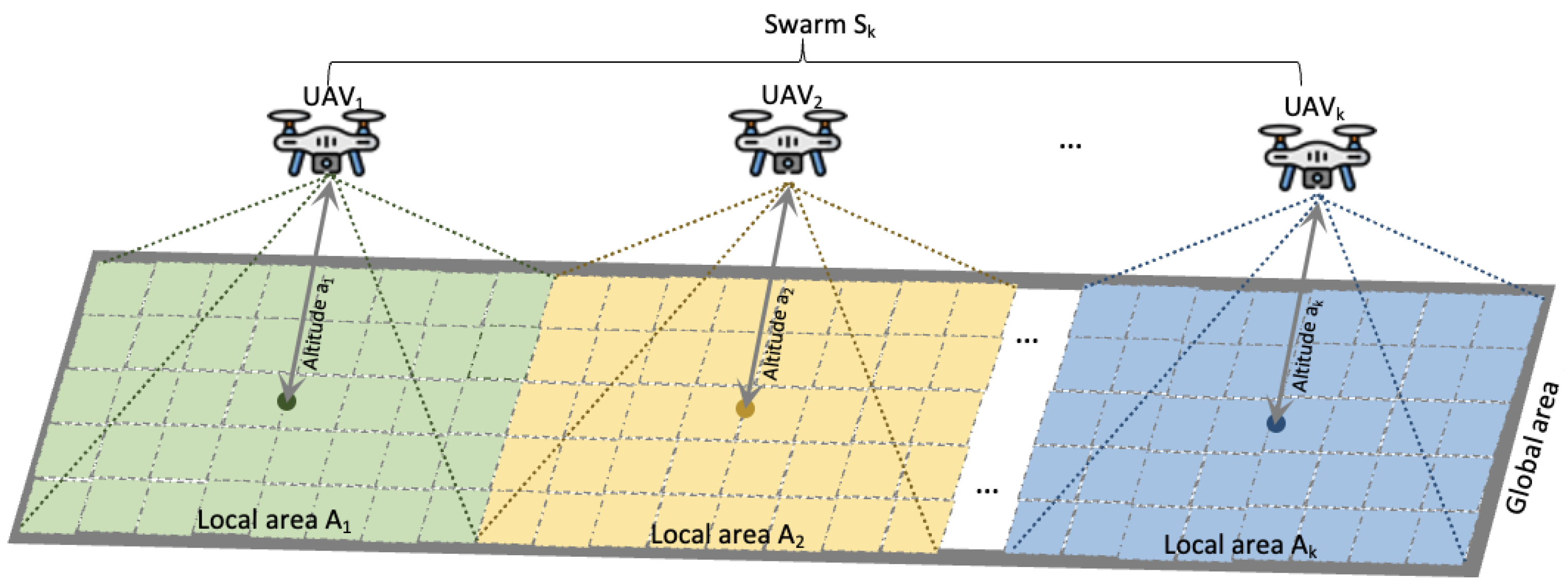


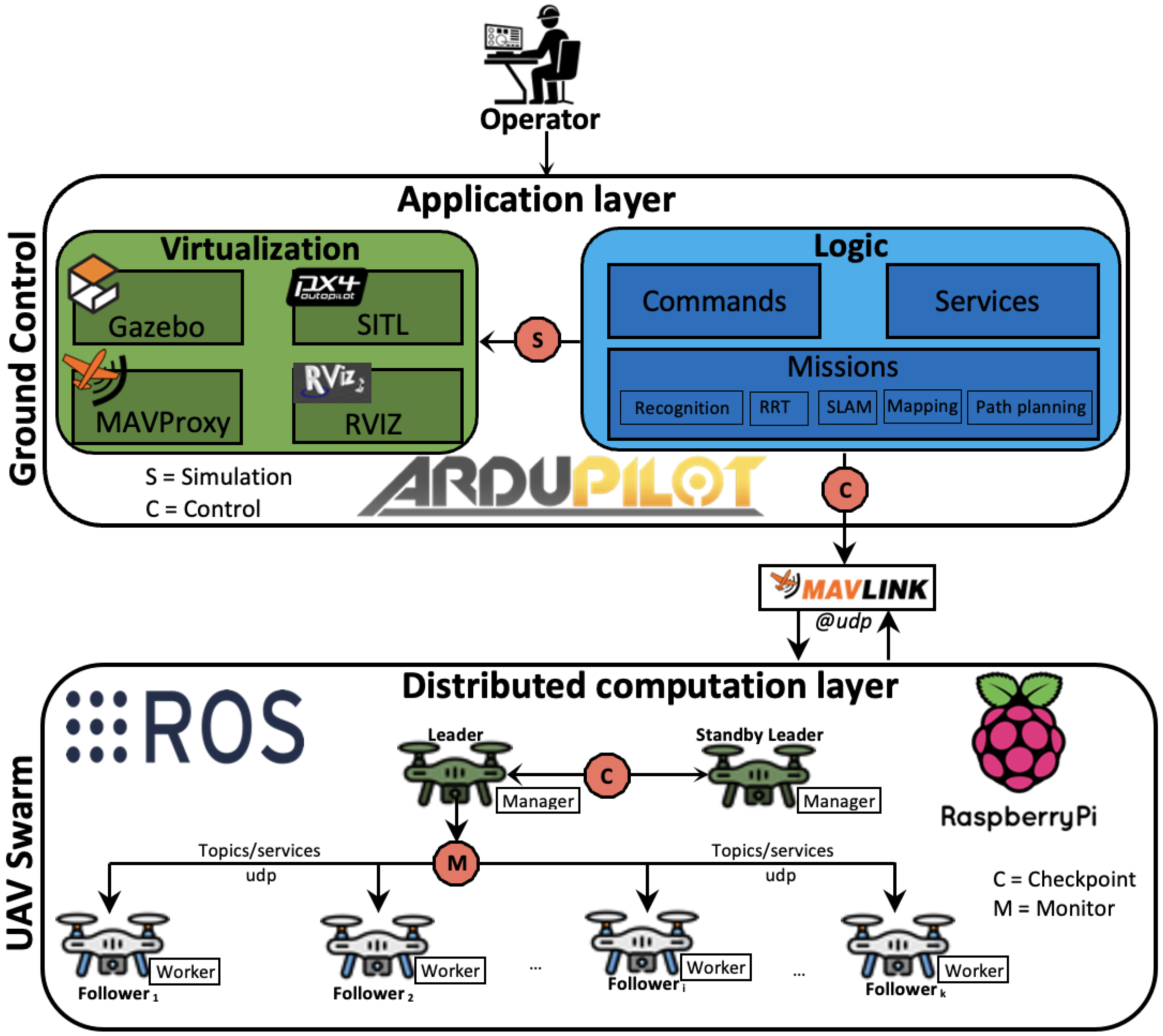
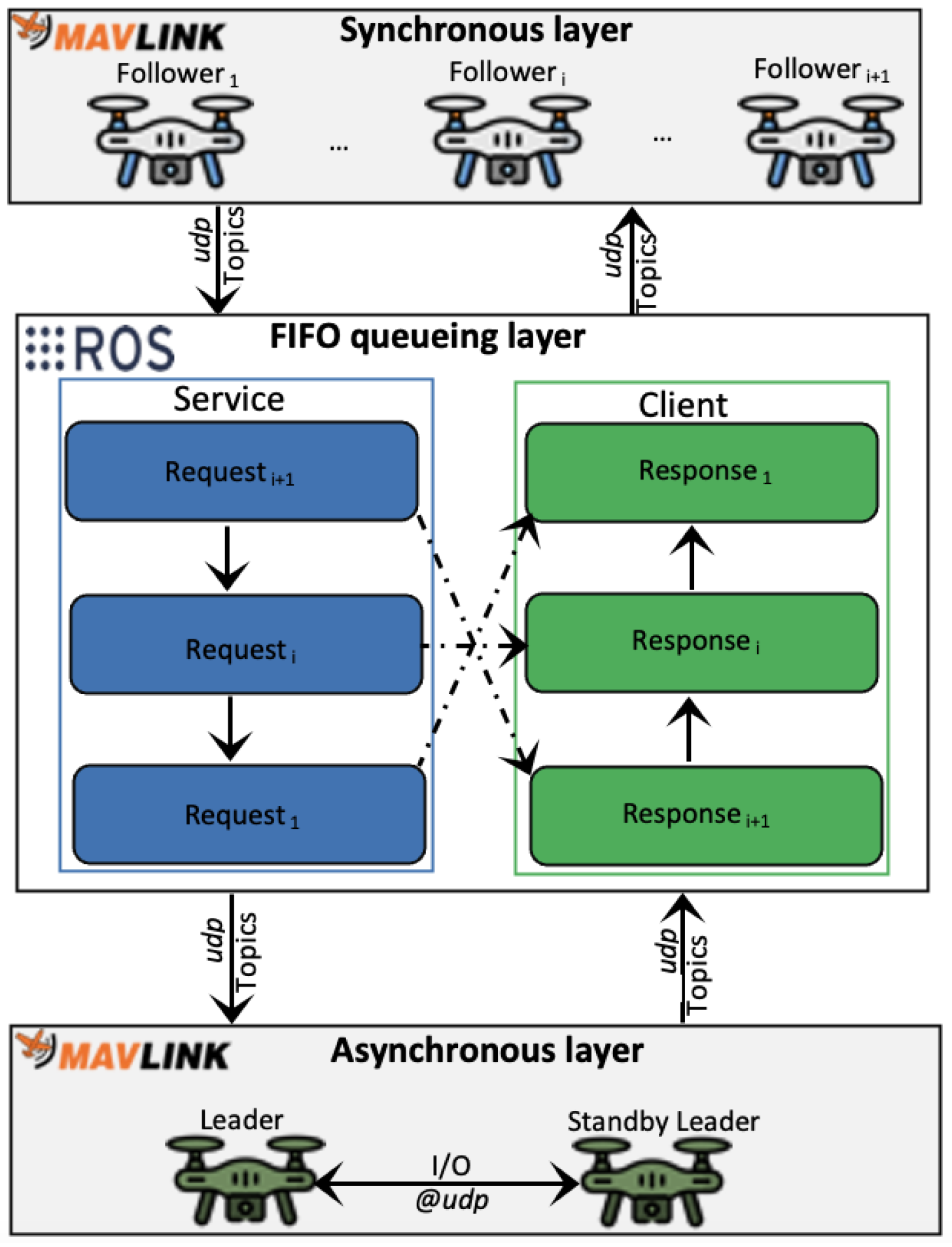
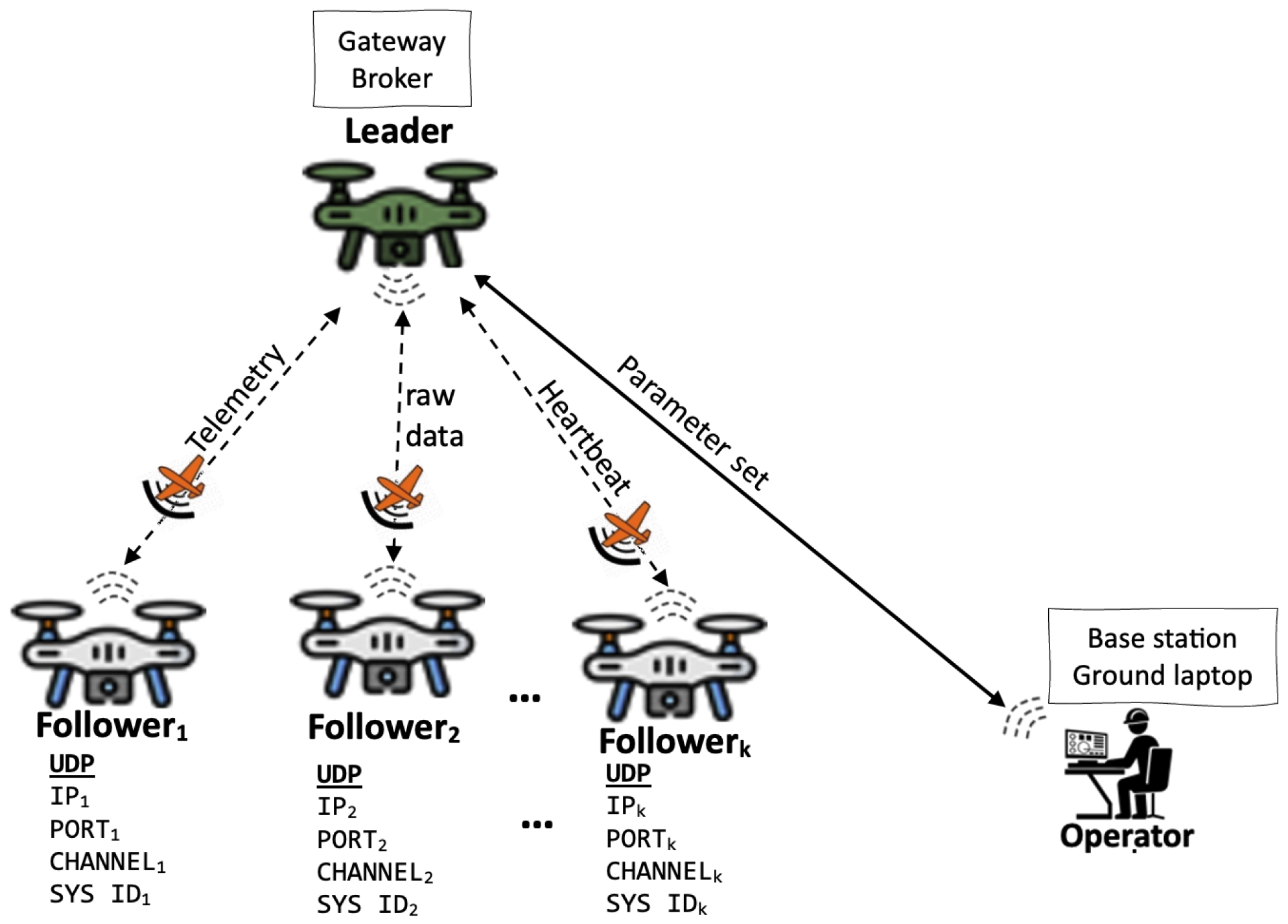



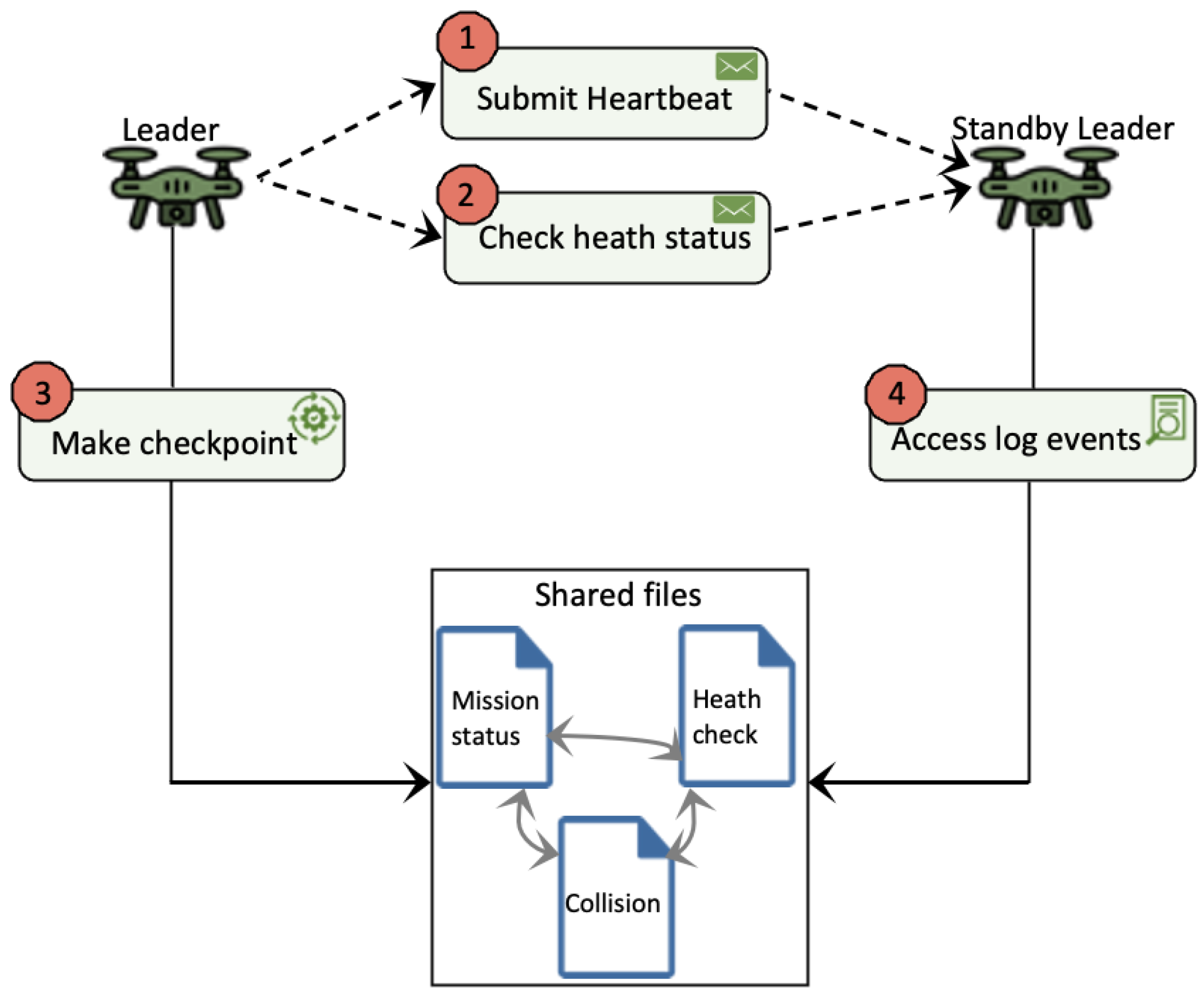
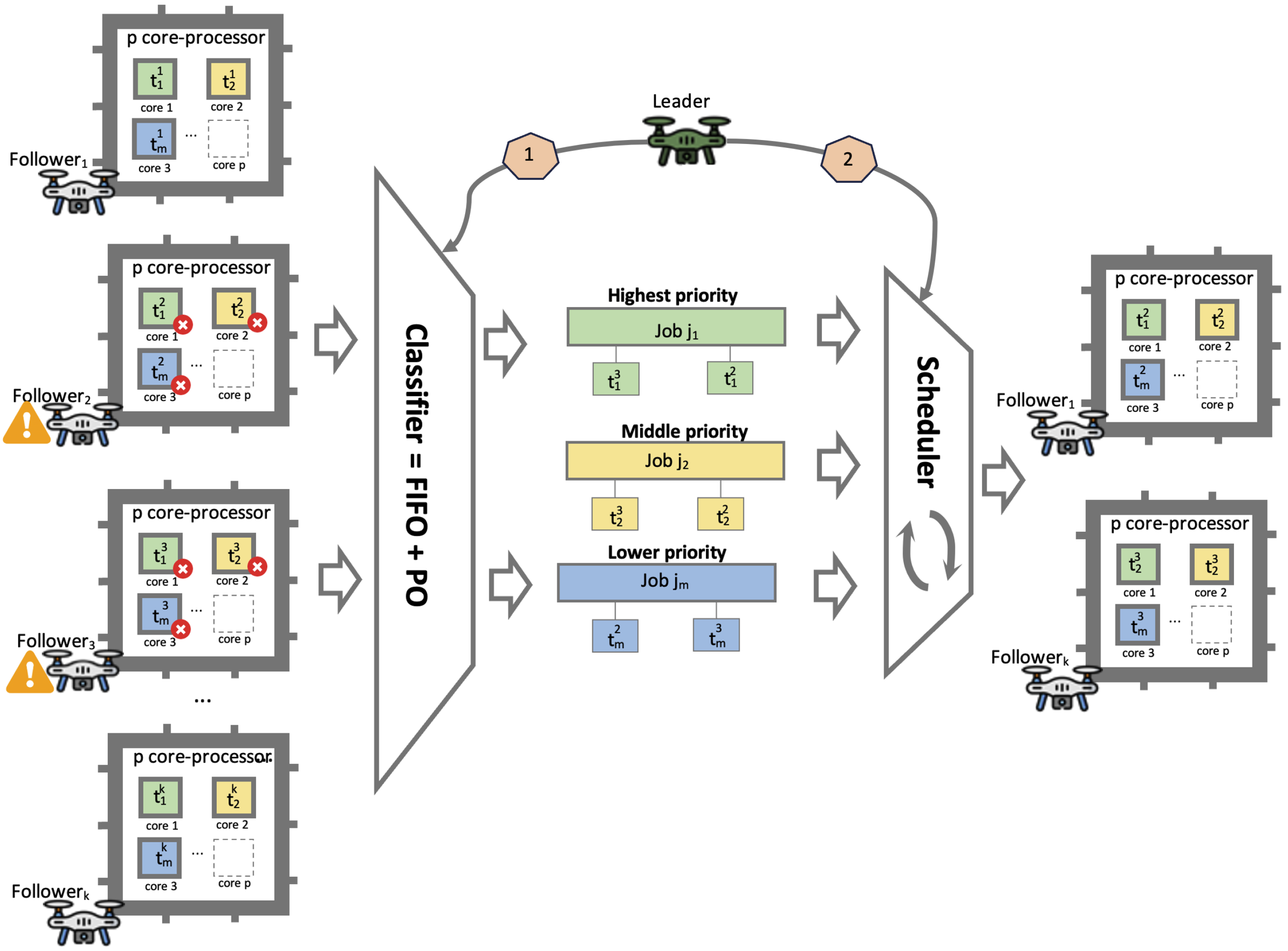

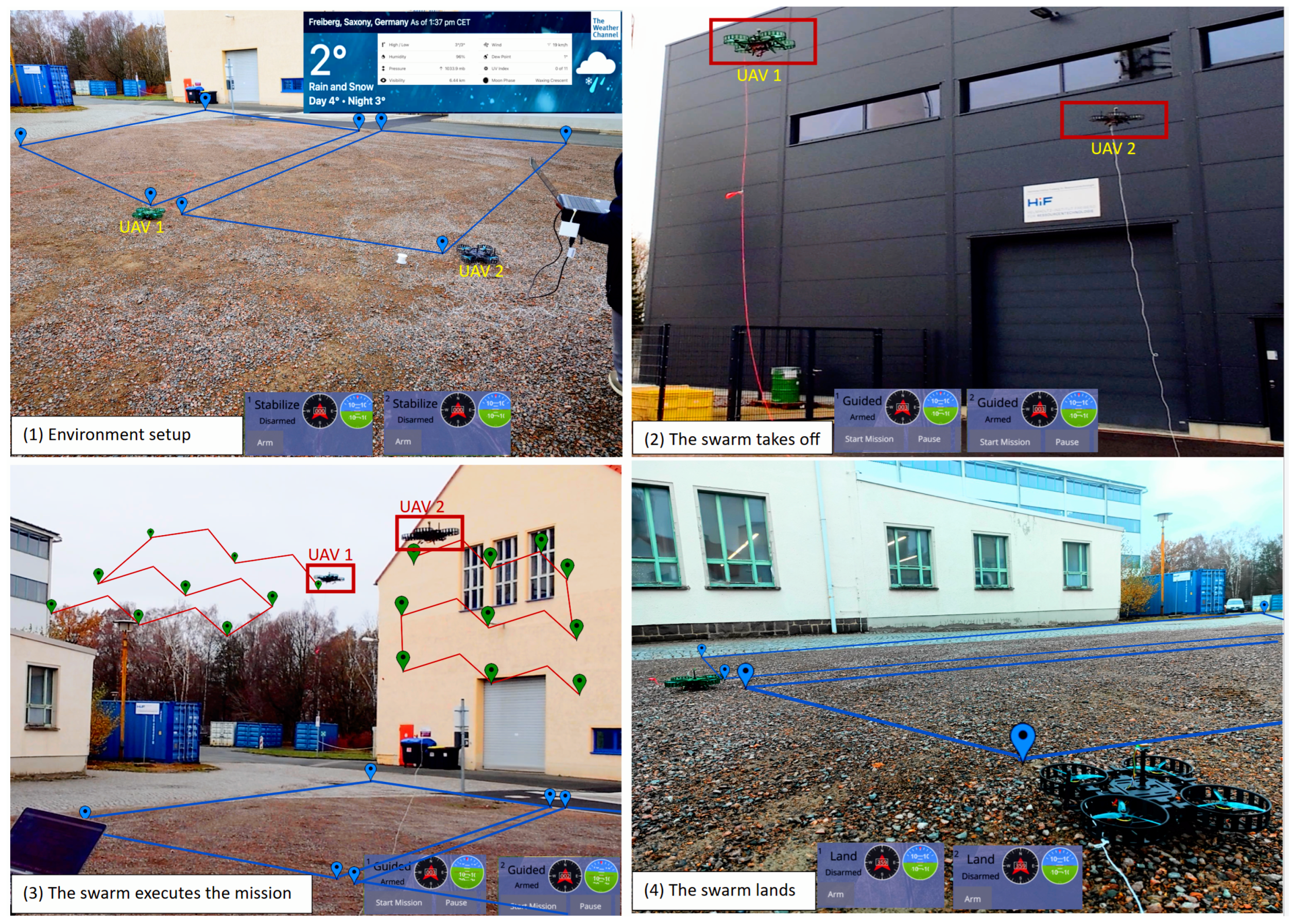
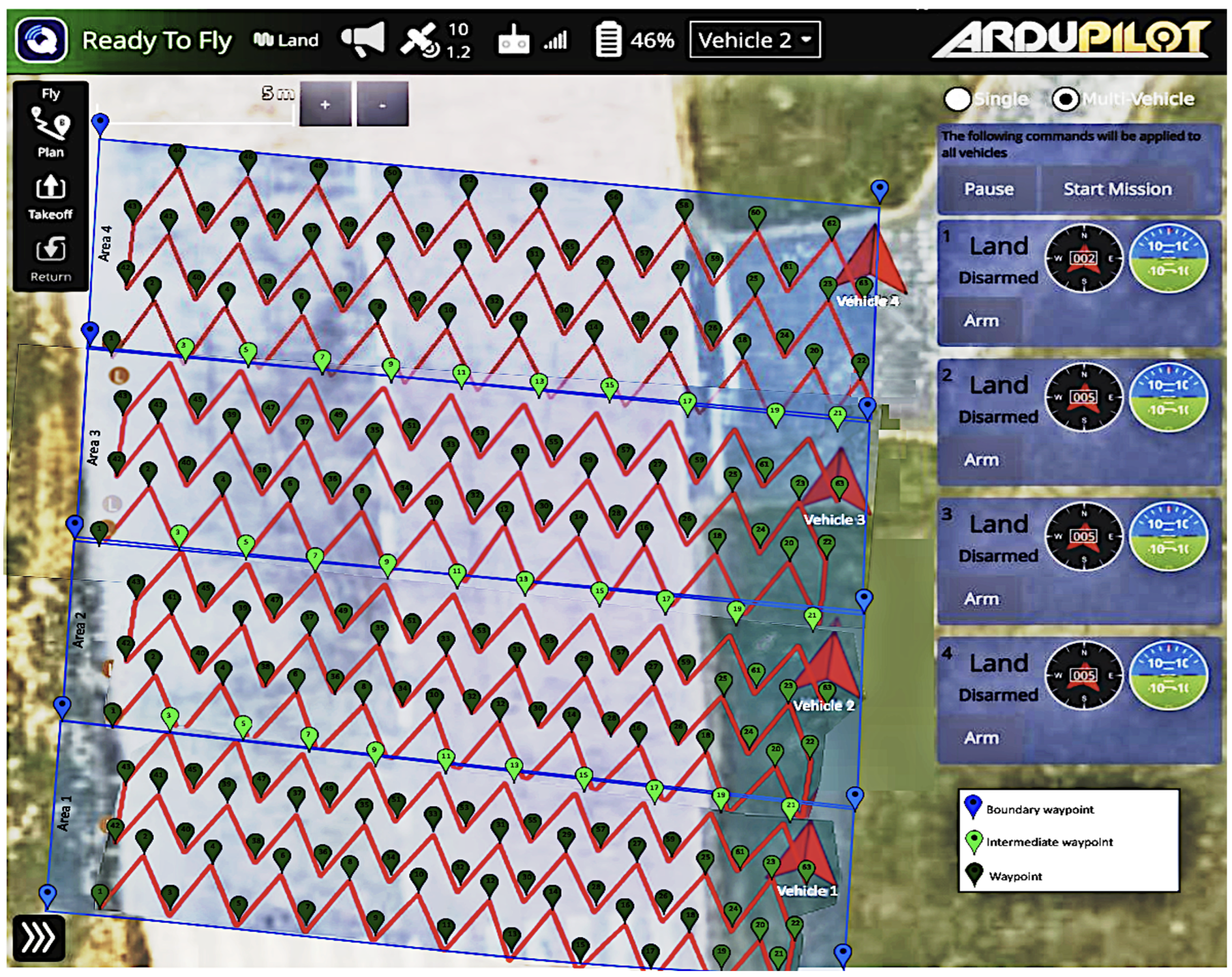

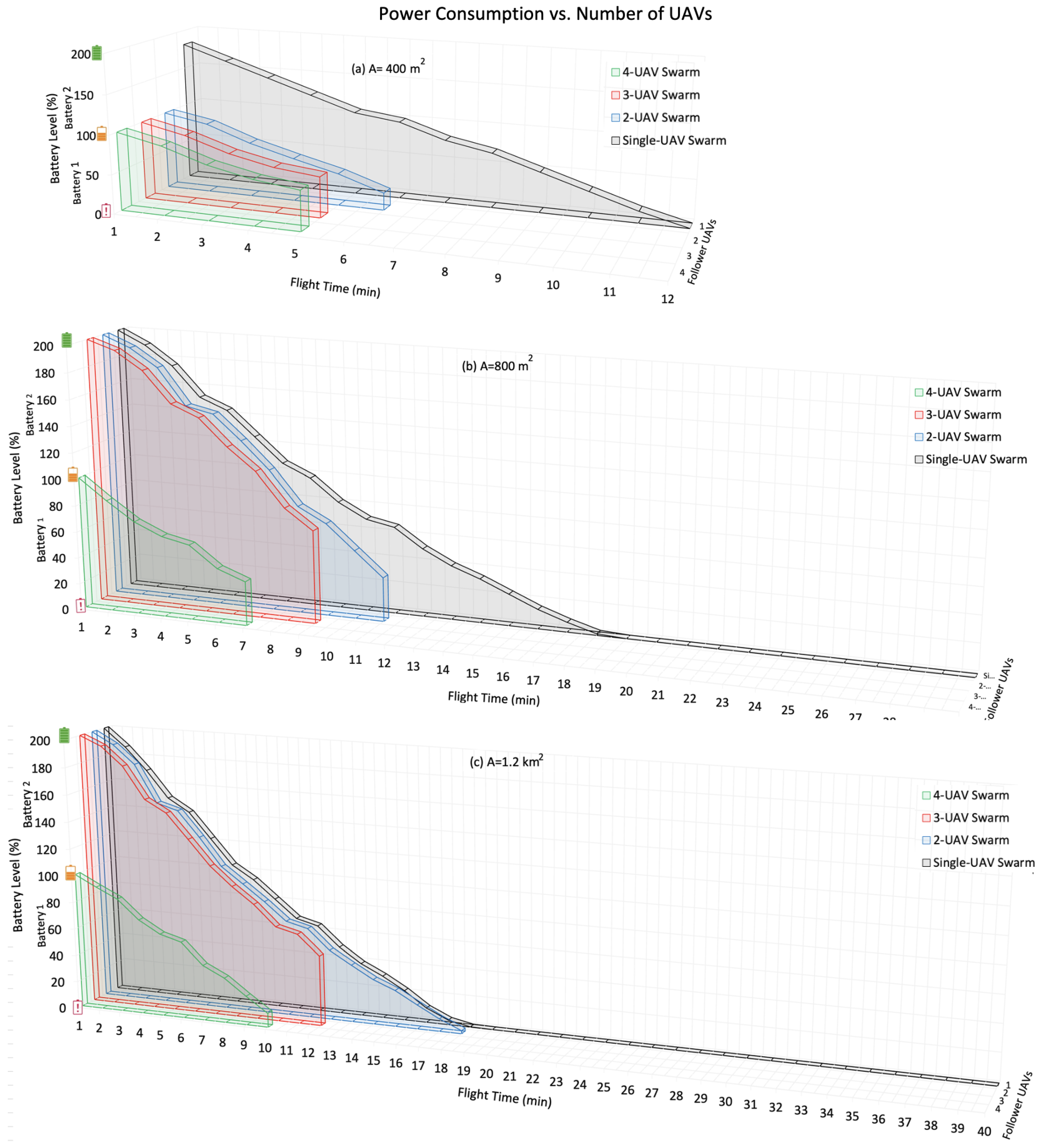

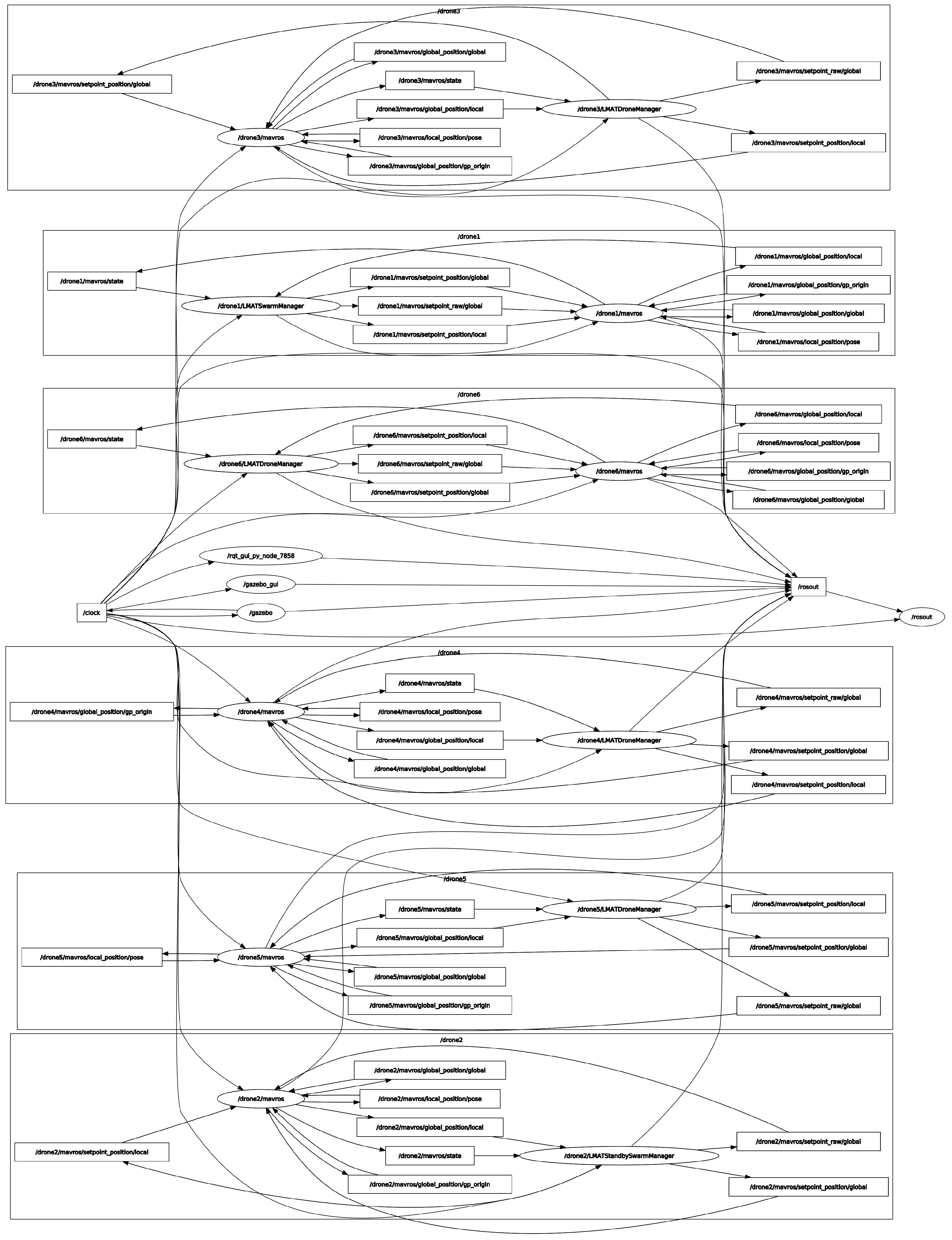
| Aspect | Methods | Challenges | Advantages | Weak Points |
|---|---|---|---|---|
| Fault detection | -Redundancy-based monitoring [54] -AI-based anomaly detection [55] | -Significant supervision and redundancy of drone actions and status -Real-time processing of data fusion | -Real-time recognition of anomalies -Proactive failure management | -Misdiagnosis of faults or false positives leading to complete mission failures |
| Task allocation | -Centralized allocation [56,57] -Decentralized allocation [58] -Dynamic allocation [59,60] | -Resilience to faults -Communication overheads -Reassignment of tasks on available resources | -Highly resource efficient -Adaptive fault response | -Misallocation of tasks leads to bottlenecks or unbalanced resources and workloads |
| Task synchronization | -Time-based synchronization [61] -Event-based synchronization [62,63] | -Reliability of communication network -Time constraints -Sharing global timing clocks | -Fine-tuned coordination for intricate task planning -Adaptive task allocation | -Synchronization delays or misaligned tasks cause mission failure |
| Consensus control | -Proportional consensus [64] -Leader–Follower consensus [65] -Time-delayed consensus [66] | -Time-consuming communication -Vulnerable to erroneous consensus -Convergence rapidity | -Uniform behaviors throughout the swarm -Convergence to optimal decision making | -Vulnerability to hardware failure or loss of communication -Divergent behavior quickly affects the drones swarm |
| Collective perception | -Data fusion [67] -Voting mechanism [68] -Distributed perception [69] | -Merging multisource data from multi-UAV sensors | -Holistic understanding of the environment -Coordinated swarm mobility | -Incoherent perceptions may result in navigation errors or collisions |
| Time Delay (ms) | ||||
|---|---|---|---|---|
| pkts | k = 1 | k = 2 | k = 3 | k = 4 |
| 40.54 | 45.28 | 41.92 | 46.84 | |
| 45.50 | 41.18 | 49.48 | 46.20 | |
| 44.28 | 43.16 | 45.82 | 42.32 | |
| 49.07 | 44.24 | 42.82 | 42.84 | |
| 42.76 | 45.98 | 46.94 | 43.96 | |
| 43.34 | 43.66 | 45.09 | 47.24 | |
| Average time (ms) | 44.24 | 43.41 | 45.01 | 44.9 |
| Mean latency (ms) | 44.39 | |||
| Features | Our System | Sial [101] | Rune [97] | João [98] | |
|---|---|---|---|---|---|
| Programming framework | ROS1 | ☑ | ✖ | ☑ | ☑ |
| ROS2 | ☑ | ✖ | ☑ | ✖ | |
| Network architecture | Centralized | ✖ | ✖ | ☑ | ☑ |
| Decentralized | ☑ | ☑ | ✖ | ✖ | |
| Communication mode | Air2Ground | ☑ | ☑ | ☑ | ☑ |
| Air2Air | ☑ | ☑ | ✖ | ✖ | |
| Air2Cloud | ✖ | ✖ | ☑ | ☑ | |
| Secure | ✖ | ✖ | ☑ | ☑ | |
| Swarm intelligence | Collaborative | ☑ | ☑ | ☑ | ☑ |
| Consensus control | ☑ | ☑ | ✖ | ✖ | |
| Resilience | ☑ | ✖ | ✖ | ✖ | |
| Self-organized | ☑ | ☑ | ✖ | ✖ | |
| Failover system | ☑ | ✖ | ✖ | ✖ | |
| Collision avoidance | ✖ | ✖ | ☑ | ✖ | |
| Proofs of concept | Simulation | ☑ | ☑ | ☑ | ☑ |
| Real-world | ☑ | ✖ | ☑ | ☑ | |
Disclaimer/Publisher’s Note: The statements, opinions and data contained in all publications are solely those of the individual author(s) and contributor(s) and not of MDPI and/or the editor(s). MDPI and/or the editor(s) disclaim responsibility for any injury to people or property resulting from any ideas, methods, instructions or products referred to in the content. |
© 2024 by the authors. Licensee MDPI, Basel, Switzerland. This article is an open access article distributed under the terms and conditions of the Creative Commons Attribution (CC BY) license (https://creativecommons.org/licenses/by/4.0/).
Share and Cite
Adoni, W.Y.H.; Fareedh, J.S.; Lorenz, S.; Gloaguen, R.; Madriz, Y.; Singh, A.; Kühne, T.D. Intelligent Swarm: Concept, Design and Validation of Self-Organized UAVs Based on Leader–Followers Paradigm for Autonomous Mission Planning. Drones 2024, 8, 575. https://doi.org/10.3390/drones8100575
Adoni WYH, Fareedh JS, Lorenz S, Gloaguen R, Madriz Y, Singh A, Kühne TD. Intelligent Swarm: Concept, Design and Validation of Self-Organized UAVs Based on Leader–Followers Paradigm for Autonomous Mission Planning. Drones. 2024; 8(10):575. https://doi.org/10.3390/drones8100575
Chicago/Turabian StyleAdoni, Wilfried Yves Hamilton, Junaidh Shaik Fareedh, Sandra Lorenz, Richard Gloaguen, Yuleika Madriz, Aastha Singh, and Thomas D. Kühne. 2024. "Intelligent Swarm: Concept, Design and Validation of Self-Organized UAVs Based on Leader–Followers Paradigm for Autonomous Mission Planning" Drones 8, no. 10: 575. https://doi.org/10.3390/drones8100575
APA StyleAdoni, W. Y. H., Fareedh, J. S., Lorenz, S., Gloaguen, R., Madriz, Y., Singh, A., & Kühne, T. D. (2024). Intelligent Swarm: Concept, Design and Validation of Self-Organized UAVs Based on Leader–Followers Paradigm for Autonomous Mission Planning. Drones, 8(10), 575. https://doi.org/10.3390/drones8100575








